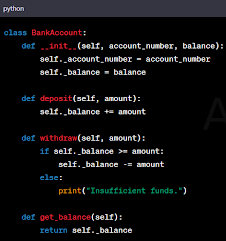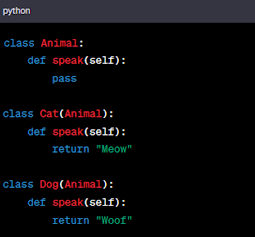Introduction
Welcome to the ultimate guide on object-oriented programming (OOP)! In this comprehensive article, we will dive deep into the concepts and principles that form the foundation of OOP. Whether you are a beginner looking to grasp the basics or an experienced programmer aiming to enhance your skills, this guide is designed to provide you with a thorough understanding of object-oriented programming.
What is Object-Oriented Programming?
Object-Oriented Programming (OOP) is a
programming paradigm that revolves around the concept of objects, which are
instances of classes. It provides a structured approach to designing and
organizing code by focusing on objects and their interactions. OOP promotes
code reusability, modularity, and maintainability, making it a widely adopted
paradigm in software development.
Explain Concepts of Object-Oriented Programming
Classes and Objects
At the core of object-oriented programming
lies the concept of classes and objects. A class can be seen as a blueprint or
template that defines the properties (attributes) and behaviors (methods) of
objects. It encapsulates related data and functions into a single unit.
In the example above, we define a `Car` class with the attributes `make` and `model`, and a method `start_engine()` that prints a message indicating the engine is running. An object, also known as an instance, is created from a class.
Inheritance
Inheritance is a fundamental concept in OOP that enables the creation of new classes based on existing ones. It establishes an "is-a" relationship between classes, where the derived class inherits the attributes and methods of the base class.
In this example, the `ElectricCar` class inherits from the `Car` class. It not only has its own unique methods like `charge_battery()`, but also inherits the `make` and `model` attributes as well as the `start_engine()` method from the `Car` class. This allows us to reuse code and build upon existing functionality.
Polymorphism
Polymorphism is the ability of objects to
take on multiple forms or behaviors depending on the context. It allows
different classes to implement the same method name in different ways. This
concept enhances flexibility and extensibility in OOP.
In this example, both the `Circle` and `Rectangle` classes have a method called `calculate_area()`, but each class implements it differently based on its specific shape. When calling the method on different objects, polymorphism ensures that the correct implementation is executed.
 Encapsulation
Encapsulation
Encapsulation is the practice of hiding
internal details and providing controlled access to an object's properties and
methods. It prevents direct manipulation of data from outside the object,
promoting data integrity and security.
In this example, the `BankAccount` class
encapsulates the account number and balance as private attributes
(`_account_number` and `_balance`). External code cannot directly modify these
attributes but can interact with them through the public methods `deposit()`,
`withdraw()`, and `get_balance()`.
 Abstraction
Abstraction
Abstraction in OOP involves simplifying complex systems by breaking them down into manageable and understandable components. It allows programmers to focus on essential details while hiding unnecessary complexities.
In this example, the `Shape` class represents an abstract concept, and its `calculate_area()` method is defined as an abstract method using the `abstractmethod` decorator. This enforces that any class derived from `Shape` must implement this method. The `Square` class provides the implementation specific to calculating the area of a square.
Association
Association in OOP signifies a relationship between two or more classes. It allows objects to interact and collaborate with each other to achieve a desired result. Associations can be classified as one-to-one, one-to-many, or many-to-many.
In this example, the `Driver` class and the
`Car` class are associated with each other. The `start_car()` method of the
`Driver` class receives an instance of the `Car` class as a parameter and
interacts with it to start the car.
How Does Object-Oriented Programming Work?
Object-oriented programming works by creating classes, which are blueprints or templates for objects. These classes define the attributes and methods that objects of that class will have. Objects are instances of classes, created using the `class_name()` syntax.
When an object is created, it can access
and modify its attributes and invoke its methods. Objects can interact with
each other through associations, inheritance, and polymorphism. The behavior
and functionality of objects are defined by the implementation within the
class.
OOP also follows
key principles like encapsulation, which hides internal details, and
abstraction, which simplifies complex systems. These principles promote code
reusability, modularity, and maintainability.
Advantages of Object-Oriented Programming
Object-oriented programming offers several advantages, including:
1.
Modularity:
OOP enables code to be divided into smaller, self-contained modules (classes), making it easier to understand, maintain, and reuse code.
2.
Code Reusability:
Through inheritance, objects can inherit attributes and methods from existing classes, reducing code duplication and promoting efficient development.
3.
Flexibility and Extensibility:
Polymorphism allows objects to take on different forms, making it easy to introduce new functionality without modifying existing code.
4.
Improved Code Organization:
OOP provides a clear structure for organizing code, making it more readable and understandable for developers.
5.
Enhanced Productivity:
OOP's modular and reusable nature speeds up the development process, allowing for faster and more efficient coding.
6.
Collaborative Development:
OOP promotes
team collaboration by enabling developers to work on different classes
simultaneously without conflicting with each other's code.
Disadvantages of Object-Oriented Programming
While object-oriented programming has numerous advantages, it also has some disadvantages, including:
1.
Steep Learning Curve:
OOP can be complex, especially for beginners, due to its multitude of concepts and principles. It requires a solid understanding of abstraction, inheritance, and polymorphism.
2.
Increased Memory Usage:
OOP often requires objects to store additional information about their structure and relationships, which can result in increased memory usage compared to other programming paradigms.
3.
Performance Overhead:
The encapsulation and abstraction layers in OOP can introduce performance overhead, especially in highly resource-constrained environments.
4.
Design Complexity:
Properly designing object-oriented systems requires careful consideration of class relationships, inheritance hierarchies, and object interactions, which can sometimes lead to complex designs.
5.
Overuse of Inheritance:
Inappropriate use of inheritance can lead to code that is tightly coupled, making it harder to maintain and modify.
6.
Development Overhead:
Developing an object-oriented system often requires more time and effort due to the upfront design and planning required.
Commonly Used Object-Oriented Programming Languages
Object-oriented programming is supported by
numerous programming languages, some commonly used languages are:
1.
Java:
A popular language known for its extensive support for OOP principles. Java's class-based structure and rich ecosystem make it widely adopted in enterprise applications.
2.
Python:
Python's simplicity and readability, combined with its support for OOP, make it a preferred choice for beginners and experienced developers alike. It offers a smooth learning curve and powerful libraries.
3.
C++:
A language
renowned for its efficiency and performance, C++ provides strong support for
OOP. It is often used in game development, system programming, and
resource-constrained environments.
4.
C#:
Developed by
Microsoft, C# is heavily influenced by Java and provides a robust framework for
developing Windows applications and web services using OOP principles.
5.
Ruby:
Ruby's elegant syntax and dynamic nature make it a popular choice for web development and scripting. It emphasizes developer productivity and follows OOP principles closely.
6.
PHP:
Primarily used for web development, PHP has evolved to include OOP features. It powers many popular content management systems and web applications.
These are just a few examples of languages
that support object-oriented programming. Each language has its own unique
features and strengths, so the choice of language depends on the specific
requirements and preferences of the project.
FAQs
1. What is the main goal of object-oriented programming?
The main goal of object-oriented programming is to provide a structured and modular approach to software development. It aims to improve code reusability, maintainability, and scalability by organizing code into objects that encapsulate both data and behavior.
2. Is object-oriented programming only used in software development?
No, object-oriented programming is not limited to software development. Its principles can be applied to various domains, including hardware design, artificial intelligence, and data analysis. OOP's modularity and code organization benefits make it applicable beyond traditional software development.
3. Can you provide an example of inheritance in object-oriented programming?
Certainly! Let's consider an example where we have a base class called `Animal` and two derived classes called `Cat` and `Dog`.In this example, both `Cat` and `Dog`
inherit the `speak()` method from the `Animal` class. However, each derived
class implements the `speak()` method differently. This demonstrates how
inheritance allows classes to share common functionality while providing their
own specialized behavior.
4. How does polymorphism contribute to code reusability?
Polymorphism plays a crucial role in code reusability by enabling objects to be treated as instances of their base class or any of their derived classes. This means that code written for the base class can be reused with any derived class, as long as they share the same interface or method signature.
5. What is the difference between encapsulation and
abstraction?
Encapsulation and abstraction are closely related but distinct concepts in object-oriented programming. Encapsulation involves bundling data and methods within a class and controlling access to them. It focuses on hiding internal details and providing a controlled interface.
Abstraction, on the other hand, simplifies complex systems by breaking them down into manageable components. It emphasizes providing essential functionality while hiding unnecessary implementation details. Abstraction can be achieved through interfaces, abstract classes, and inheritance hierarchies.
6. Is it possible to combine object-oriented programming with other programming paradigms?
Yes, it is possible to combine object-oriented programming with other paradigms like procedural programming or functional programming. Many programming languages support multiple paradigms, allowing developers to choose the most suitable approach for a specific task or problem.
Conclusion
Object-oriented programming is a powerful and widely used programming paradigm that brings numerous benefits to software development. Organizing code into objects, it promotes code reusability, modularity, and maintainability. Understanding the key concepts of OOP, such as classes, objects, inheritance, polymorphism, encapsulation, and abstraction, is essential for any developer aiming to build robust and scalable applications.
While OOP has its advantages and
disadvantages, its flexibility and extensibility make it a popular choice for a
wide range of applications. By following OOP principles and leveraging the
features provided by programming languages that support OOP, developers can
write clean, modular, and efficient code.










Comments
Post a Comment